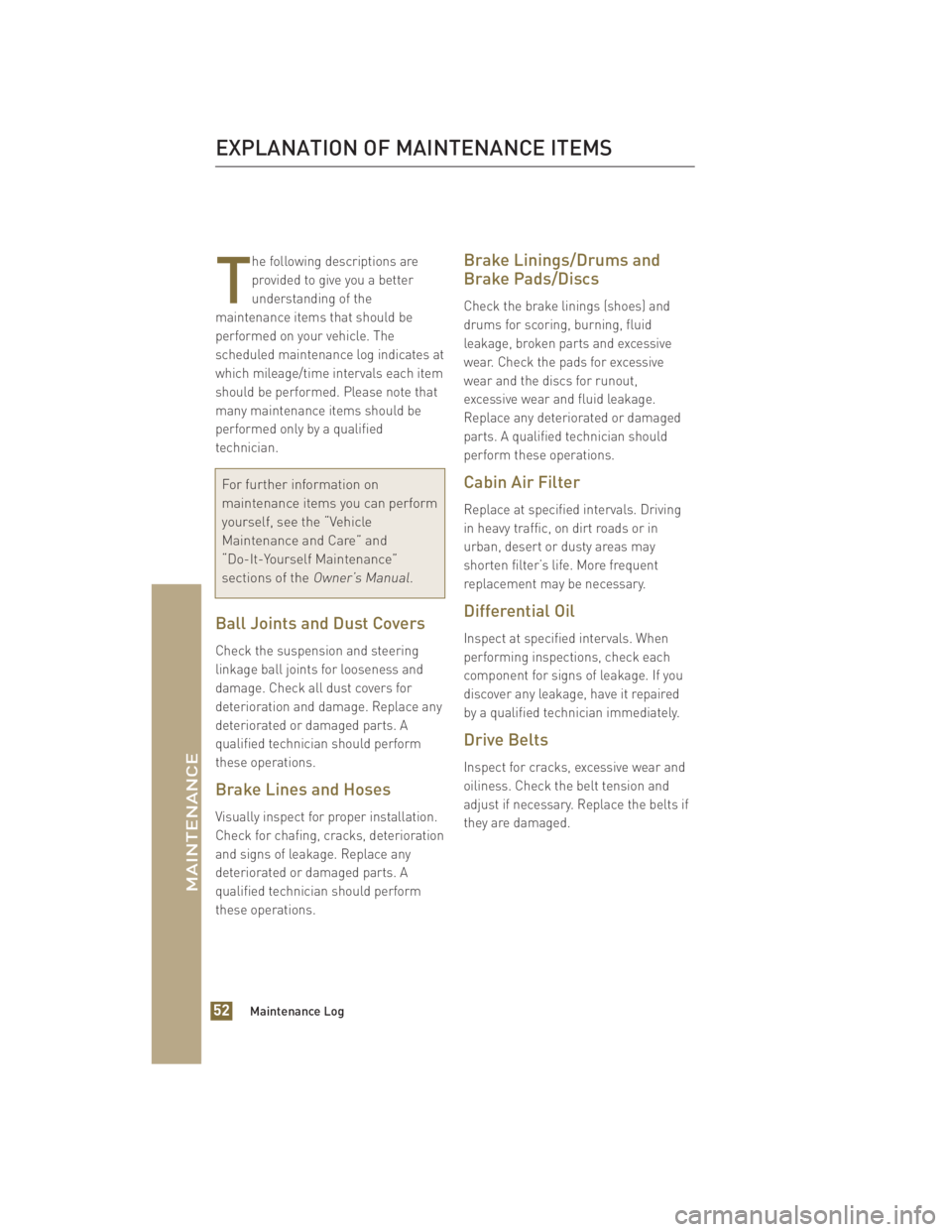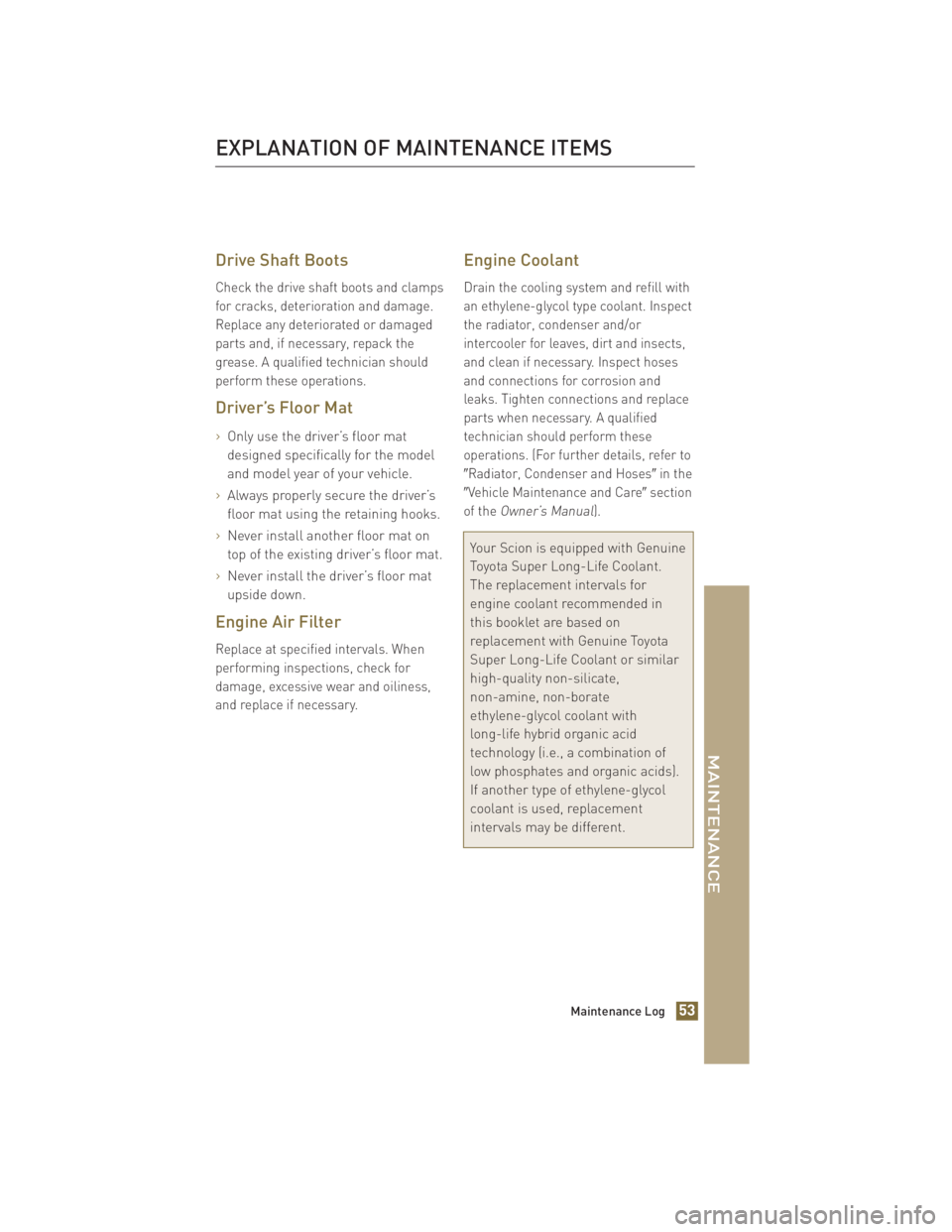Page 54 of 58

T
he following descriptions are
provided to give you a better
understanding of the
maintenance items that should be
performed on your vehicle. The
scheduled maintenance log indicates at
which mileage/time intervals each item
should be performed. Please note that
many maintenance items should be
performed only by a qualified
technician.
For further information on
maintenance items you can perform
yourself, see the “Vehicle
Maintenance and Care” and
“Do-It-Yourself Maintenance”
sections of the
Owner’s Manual.
Ball Joints and Dust Covers
Check the suspension and steering
linkage ball joints for looseness and
damage. Check all dust covers for
deterioration and damage. Replace any
deteriorated or damaged parts. A
qualified technician should perform
these operations.
Brake Lines and Hoses
Visually inspect for proper installation.
Check for chafing, cracks, deterioration
and signs of leakage. Replace any
deteriorated or damaged parts. A
qualified technician should perform
these operations.
Brake Linings/Drums and
Brake Pads/Discs
Check the brake linings (shoes) and
drums for scoring, burning, fluid
leakage, broken parts and excessive
wear. Check the pads for excessive
wear and the discs for runout,
excessive wear and fluid leakage.
Replace any deteriorated or damaged
parts. A qualified technician should
perform these operations.
Cabin Air Filter
Replace at specified intervals. Driving
in heavy traffic, on dirt roads or in
urban, desert or dusty areas may
shorten filter’s life. More frequent
replacement may be necessary.
Differential Oil
Inspect at specified intervals. When
performing inspections, check each
component for signs of leakage. If you
discover any leakage, have it repaired
by a qualified technician immediately.
Drive Belts
Inspect for cracks, excessive wear and
oiliness. Check the belt tension and
adjust if necessary. Replace the belts if
they are damaged.
EXPLANATION OF MAINTENANCE ITEMS
Maintenance Log52
MAINTENANCE
Page 55 of 58

Drive Shaft Boots
Check the drive shaft boots and clamps
for cracks, deterioration and damage.
Replace any deteriorated or damaged
parts and, if necessary, repack the
grease. A qualified technician should
perform these operations.
Driver’s Floor Mat
>Only use the driver’s floor mat
designed specifically for the model
and model year of your vehicle.
>Always properly secure the driver’s
floor mat using the retaining hooks.
>Never install another floor mat on
top of the existing driver’s floor mat.
>Never install the driver’s floor mat
upside down.
Engine Air Filter
Replace at specified intervals. When
performing inspections, check for
damage, excessive wear and oiliness,
and replace if necessary.
Engine Coolant
Drain the cooling system and refill with
an ethylene-glycol type coolant. Inspect
the radiator, condenser and/or
intercooler for leaves, dirt and insects,
and clean if necessary. Inspect hoses
and connections for corrosion and
leaks. Tighten connections and replace
parts when necessary. A qualified
technician should perform these
operations. (For further details, refer to
�Radiator, Condenser and Hoses�in the
�Vehicle Maintenance and Care�section
of the
Owner’s Manual).
Your Scion is equipped with Genuine
Toyota Super Long-Life Coolant.
The replacement intervals for
engine coolant recommended in
this booklet are based on
replacement with Genuine Toyota
Super Long-Life Coolant or similar
high-quality non-silicate,
non-amine, non-borate
ethylene-glycol coolant with
long-life hybrid organic acid
technology (i.e., a combination of
low phosphates and organic acids).
If another type of ethylene-glycol
coolant is used, replacement
intervals may be different.
EXPLANATION OF MAINTENANCE ITEMS
Maintenance Log53
MAINTENANCE
Page 56 of 58

Engine Oil and Oil Filter
Replace the oil filter and drain and
refill the engine oil at specified
intervals. For recommended oil grade
and viscosity, refer to the
Owner’s
Manual.
Engine Valve Clearance
Inspect for tappet noise and engine
vibration and adjust if necessary. A
qualified technician should perform
this operation.
Exhaust Pipes and Mountings
Visually inspect the exhaust pipes,
muffler and hangers for cracks,
deterioration and damage. Start the
engine and listen carefully for any
exhaust gas leakage. Tighten
connections or replace parts as
necessary.
Fuel Lines and Connections,
Fuel Tank Band and Fuel Tank
Vapor Vent System Hoses
Visually inspect for corrosion, damage,
cracks, and loose or leaking
connections. Tighten connections or
replace parts as necessary.
Fuel Tank Cap Gasket
Visually inspect for cracks,
deterioration and damage and replace
if necessary.
Nuts and Bolts on Chassis
and Body
Re-tighten the seat-mounting bolts
and front/rear suspension member
retaining bolts to specified torque.
Radiator and Condenser
Inspect for damage, debris, dirt,
insects and signs of leakage. Have any
problem repaired by a qualified
technician.
Spark Plugs
Replace at specified intervals. Install
new plugs of the same type as
originally equipped. A qualified
technician should perform this
operation.
Steering Gear Box
Inspect for signs of leakage. If you
discover any leakage, have it repaired
immediately by a qualified technician.
Steering Linkage and Boots
With the vehicle stopped, check for
excessive freeplay in the steering
wheel. Inspect the linkage for bending
and damage and the dust boots for
deterioration, cracks and damage.
Replace any damaged parts. A qualified
technician should perform these
operations.
EXPLANATION OF MAINTENANCE ITEMS
Maintenance Log54
MAINTENANCE
Page 57 of 58
Tire Rotation
Tires should be rotated according to the
instructions in the
Owner’s Manual.
When rotating tires, check for damage
and uneven wear. Replace if necessary.
Transmission Fluid or Oil
Inspect at specified intervals. When
performing inspections, check each
component for signs of leakage. If you
discover any leakage, have it repaired
by a qualified technician immediately.
EXPLANATION OF MAINTENANCE ITEMS
Maintenance Log55
MAINTENANCE
Page:
< prev 1-8 9-16 17-24